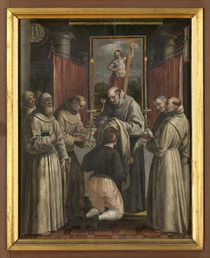The Catholic Defender: Benedict Joseph Labre
- Donald Hartley

- Apr 17
- 3 min read
Updated: Apr 19
Deepertruth with special permission and aid with Franiciscan Media, a great team for the Lord

25 March 1748 – 16 April 1783)
Labre had an uncle, a parish priest, living some distance from his family home; this uncle gladly received him, and undertook his early education for the priesthood. At the age of sixteen, he approached his uncle about becoming a Trappist monk, but his parents told him he would have to wait until he grew older.
When Benedict was about eighteen, an epidemic struck the city, and uncle and nephew busied themselves in the service of the sick. While the uncle took care of the souls and bodies of the people, Benedict went to and fro caring for the cattle. Among the last victims of the epidemic was Labre's uncle.
Benedict Joseph Labre was truly eccentric, one of God’s special little ones. Born in France and the eldest of 18 children, he studied under his uncle, a parish priest. Because of poor health and a lack of suitable academic preparation he was unsuccessful in his attempts to enter the religious life. Then, at age 16, a profound change took place. Benedict lost his desire to study and gave up all thoughts of the priesthood, much to the consternation of his relatives.
He became a pilgrim, traveling from one great shrine to another, living off alms. He wore the rags of a beggar and shared his food with the poor. Filled with the love of God and neighbor, Benedict had special devotion to the Blessed Mother and to the Blessed Sacrament. In Rome, where he lived in the Colosseum for a time, he was called “the poor man of the Forty Hours devotion” and “the beggar of Rome.” The people accepted his ragged appearance better than he did. His excuse to himself was that “our comfort is not in this world.”

St Benedict's food was composed of the leavings that fell from the tables of others. Alms that had been given to him he gave to the poor. The rags of this beggar of the Lord covered a heart that glowed with love of God and neighbor, and the tenderest devotion to the Blessed Sacrament and to the Mother of God. At Assisi he was received into the Confraternity of the Cord of St. Francis. He has been the pride of that pious society ever since.
Labre joined the Third Order of Saint Francis and settled on a life of poverty and pilgrimage. He first traveled to Rome on foot, subsisting on what he could get by begging. He then traveled to most of the major shrines of Europe, often several times each.
On April 16, 1783, the last day of his life, Benedict dragged himself to a church in Rome and prayed there for two hours before he collapsed, dying peacefully in a nearby house. Immediately after his death, the people proclaimed him a saint.
Benedict Joseph Labre's confessor, Marconi, wrote his biography and attributed 136 separate cures to his intercession within three months of his death. Those miracles were instrumental in the conversion of the Reverend John Thayer, the first American Protestant clergyman to convert to Catholicism, who was resident in Rome at the time of St. Benedict's death. Soon after his death; he was declared Blessed by Blessed Pius IX in 1860, and canonized by Pope Leo XIII in 1881. Benedict is patron saint of the homeless.
is feast day is observed on April 16.





















Comments